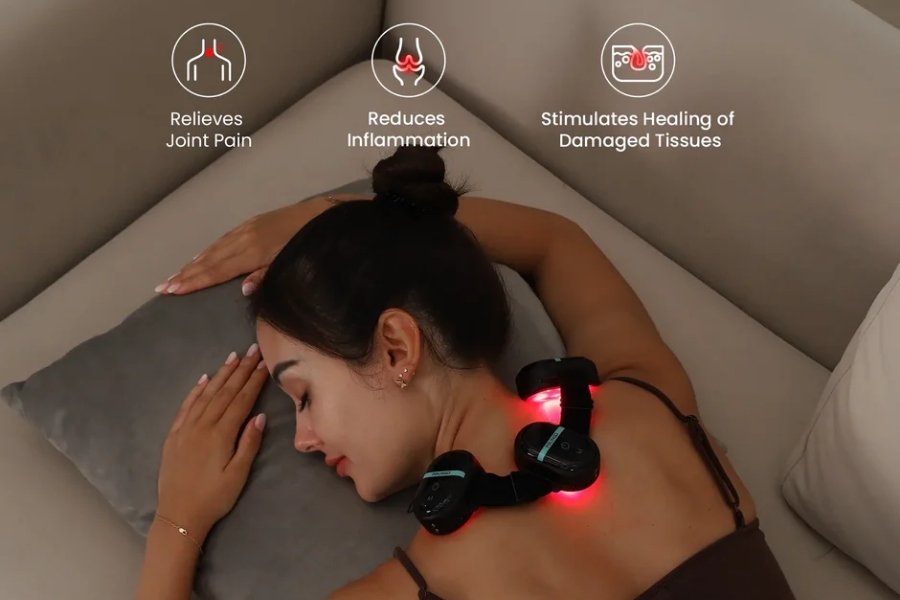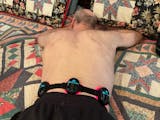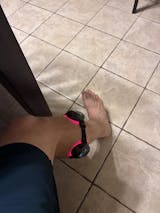Red light therapy has emerged as an important treatment for chronic pain, using specific wavelengths of light to penetrate deep into tissue and stimulate healing processes at the cellular level. This innovative treatment utilizes wavelengths, typically between 620 and 850 nanometers, that are absorbed deep into the skin, promoting cell repair and reducing inflammation—a key factor in chronic pain.
A 2019 meta-analysis published in the journal Pain Research and Management found that FDA approved red light therapy significantly reduced pain by up to 70% in patients with musculoskeletal conditions. Additionally, a clinical trial highlighted in the Journal of the American Medical Association showed that more than 80% of patients with knee osteoarthritis experienced pain relief after regular red light therapy.
These findings highlight the potential of red light therapy as an effective alternative to traditional pain management techniques, providing pain relief without the side effects of medications. In this article, we’ll explore how red light therapy relieves pain, its scientific basis, potential benefits, and how to use it effectively.
What is Red Light Therapy?
Red light therapy is a photobiomodulation therapy that uses low-wavelength red and near-infrared light to penetrate the skin and target underlying tissue.
These wavelengths, typically between 620 and 850 nanometers, are absorbed by cells and tissues, stimulating biological processes that promote healing, reduce inflammation, and relieve pain. This therapy has been studied and used in various medical fields, from dermatology to sports medicine.
The Science of Red Light Therapy for Pain

The mechanism behind FDA approved red light therapy is that when cells absorb red and near-infrared light, it boosts the production of adenosine triphosphate (ATP), the cell’s main energy source.
This surge in cellular energy promotes healing, improves circulation, and reduces inflammation, all of which help relieve pain. Let’s explore how red and near-infrared light interact with tissues to produce pain relief.
1. Cell Repair and Regeneration
One of the main ways FDA approved red light therapy reduces pain is by stimulating cell repair. When cells are exposed to a specific wavelength of red light, their ATP production is boosted. This allows cells, especially damaged cells, to function more efficiently, speeding up the repair process of muscles, tendons, and even nerves.
For people with chronic pain conditions like arthritis or fibromyalgia, using red light therapy can lead to reduced pain and increased mobility over time.
2. Reduce Inflammation
Inflammation is a major cause of pain in a variety of conditions, from sports injuries to autoimmune diseases. Red light therapy has been shown to reduce inflammation by inhibiting the production of inflammatory mediators, such as prostaglandins and cytokines.
As inflammation subsides, pressure on nerves and surrounding tissues decreases, resulting in less pain and discomfort. This makes RLT particularly effective for conditions where inflammation is a key factor, such as tendinitis and bursitis.
3. Enhanced Blood Flow and Circulation
Red light therapy helps improve microcirculation by promoting blood vessel dilation. Improved circulation ensures that oxygen and nutrients are delivered to tissues more efficiently while waste products such as lactic acid are cleared more quickly.
This is especially beneficial for those who are dealing with muscle soreness or recovering from intense physical activity, as increased blood flow helps speed up recovery and reduce pain.
4. Nerve Health and Function
Chronic pain conditions often involve nerve damage or dysfunction, which can make traditional treatments less effective. Research shows that red light therapy can promote nerve repair and improve nerve function.
By regenerating nerve cells and supporting healthier nerve pathways, RLT can reduce pain signals and restore normal nerve function, offering hope to people with neuropathy or other nerve-related pain conditions.
Red Light Therapy for Pain Management
Red light therapy can be used to treat a variety of pain-related conditions, both chronic and acute. Here are its benefits for specific areas of pain management:
1. Chronic Joint Pain and Arthritis

Red light therapy can treat rheumatoid arthritis and osteoarthritis, and it can effectively relieve pain for patients. Chronic joint pain is often caused by inflammation and cartilage degeneration.
Although red light therapy does not regenerate cartilage, it can relieve inflammation and enhance joint mobility by promoting blood circulation and tissue repair.
2. Muscle Soreness and Injury Recovery
Athletes and people who regularly engage in physical activity often experience muscle soreness and even muscle strains. Red light therapy helps speed up recovery after exercise or injury by enhancing mitochondrial activity in muscle cells. This not only reduces the sensation of pain but also helps prevent further injury by strengthening muscle fibers and improving overall tissue health.
3. Back and Neck Pain
Millions of people suffer from chronic back and neck pain, often due to poor posture, muscle tension, or underlying conditions such as herniated discs.
FDA approved red light therapy can penetrate deep into the tissue and target muscle tension and inflammation in these areas, providing pain relief without invasive treatments.
4. Neuropathic Pain
Red light therapy can be very beneficial for patients who have neuropathic pain due to nerve damage or dysfunction.
For patients with diabetic neuropathy or sciatica, where pain is caused by nerve dysfunction, red light therapy can help regenerate damaged nerve cells and reduce the intensity of pain signals.
5. Headaches and Migraines
While research is not extensive enough, some studies suggest that red light therapy may help relieve headaches and migraines. It is thought to do this by improving blood circulation in the head and neck and reducing inflammation and muscle tension.
Advantages of Red Light Therapy Over Traditional Pain Treatments
Red light therapy offers several benefits over traditional pain treatments, including:
- Non-invasive:Unlike surgical treatments or injections, RLT is completely non-invasive. No incisions or needles are required, making it a top choice for patients seeking pain relief without invasive procedures.
- No side effects:Red light therapy is generally considered safe and well-tolerated. Unlike medications such as opioids or NSAIDs, which can have serious side effects, RLT has no known long-term side effects.
- Holistic approach:While medications typically target only the symptoms of pain, red light therapy addresses the underlying causes of pain, such as inflammation, poor circulation, and tissue damage.
- Home use:With the advent of red light therapy at home, people can now receive this treatment in the comfort of their own homes. Many of these devices are designed to be easy to use, making them more accessible to chronic pain sufferers who are unable to make regular visits to a clinic.
How to Effectively Use Red Light Therapy for Pain Relief
If you’re considering trying red light therapy for pain relief, here are some key tips to maximize its effectiveness:
- Consistency is key: Like most treatments, red light therapy requires consistent use to work best. It may take several treatments before you start to notice a noticeable improvement in your pain levels.
- Target the right area:For maximum results, make sure to target the specific area where you’re feeling pain. Many red light therapy devices are designed for localized treatment, making it easy to focus on specific joints, muscles, or nerve areas.
- Speak to a healthcare provider:While RLT is generally safe, it’s still a good idea to speak to a healthcare professional, especially if you have underlying health conditions. They can help guide you on whether RLT is appropriate for your specific situation.
How to Choose the Best Red Light Therapy Devices?
When choosing the best FDA approved red light therapy device, you should consider several key factors, including the type of light source, the power of the device, the coverage area, user convenience, and price.
If you are looking for a device that is easy to carry and wearable, PRUNGO's medical-grade red light therapy devices are an excellent choice. Not only can this device be used on all parts of the body, but its design also includes a portable charging box, which is perfect for users who need to travel frequently or want to be able to treat it at any time.

PRUNGO's medical-grade red light therapy devices are respected for their high efficacy and user-friendly design. It can provide continuous and stable red light exposure at home or on the go to help relieve pain and promote physical recovery. By choosing PRUNGO medical-grade red light therapy devices, you will have a reliable treatment partner to help you relieve discomfort and improve your quality of life anytime, anywhere.
Conclusion
In summary, FDA-approved red light therapy offers a promising approach to pain relief that combines innovation and simplicity. By delivering specific wavelengths of light deep into the tissue, this therapy can stimulate cellular activity that promotes healing and reduces inflammation, thereby addressing the root cause of pain without invasive surgery or medications.
The evidence supporting its effectiveness is growing, with many studies highlighting its ability to significantly relieve pain in a variety of conditions. As technology advances and more portable and user-friendly devices become available, red light therapy is expected to become an increasingly accessible and popular option for those seeking effective pain management solutions.
Whether you suffer from chronic joint pain, are recovering from an injury, or have a nerve-related condition, red light therapy may provide the relief you need. It is important to approach any new treatment with caution and consult a professional to ensure it fits your health needs.
Related reading: How much does red light therapy cost?
















Share:
What Is the Best Pain Relief for Rheumatoid Arthritis?
Types of Red Light Therapy: What Do You Know?